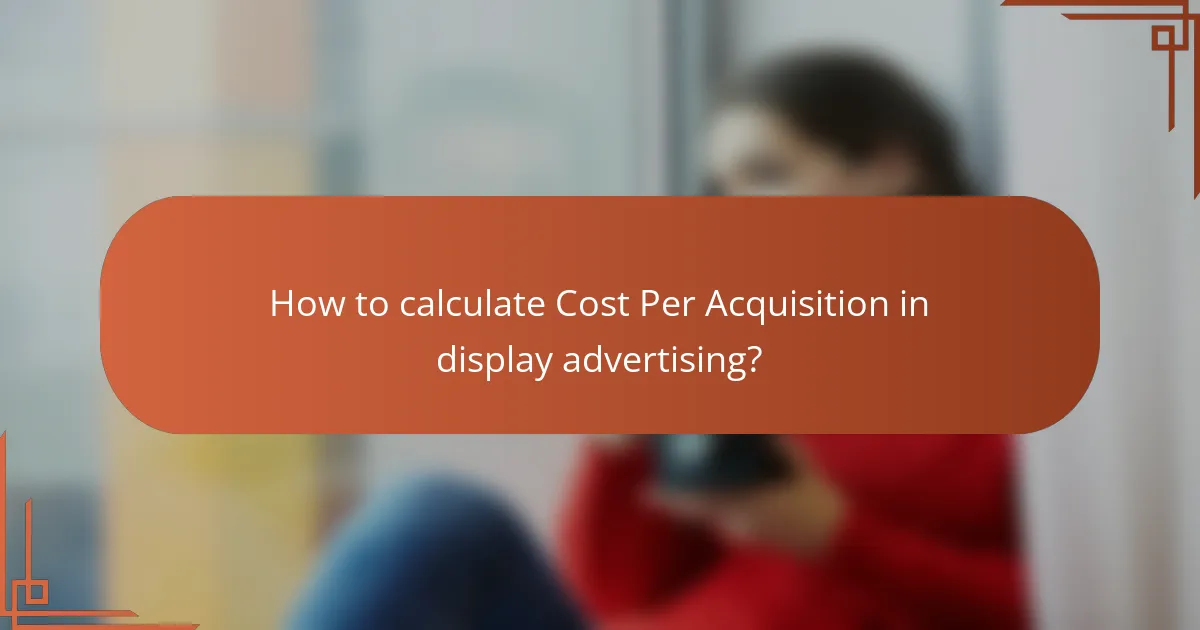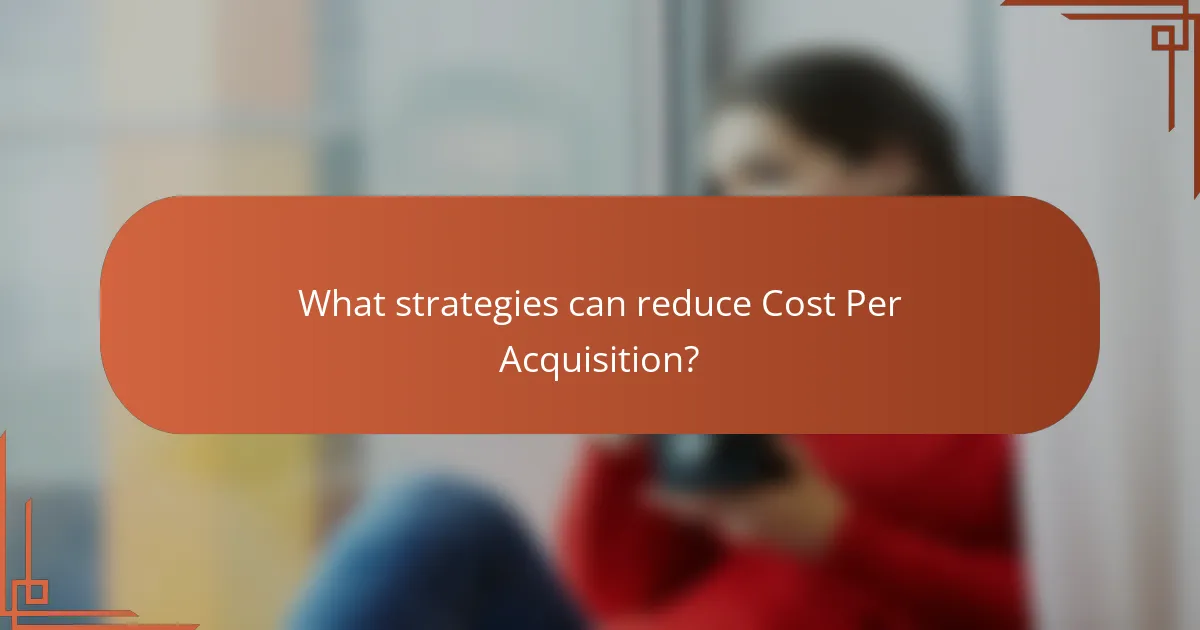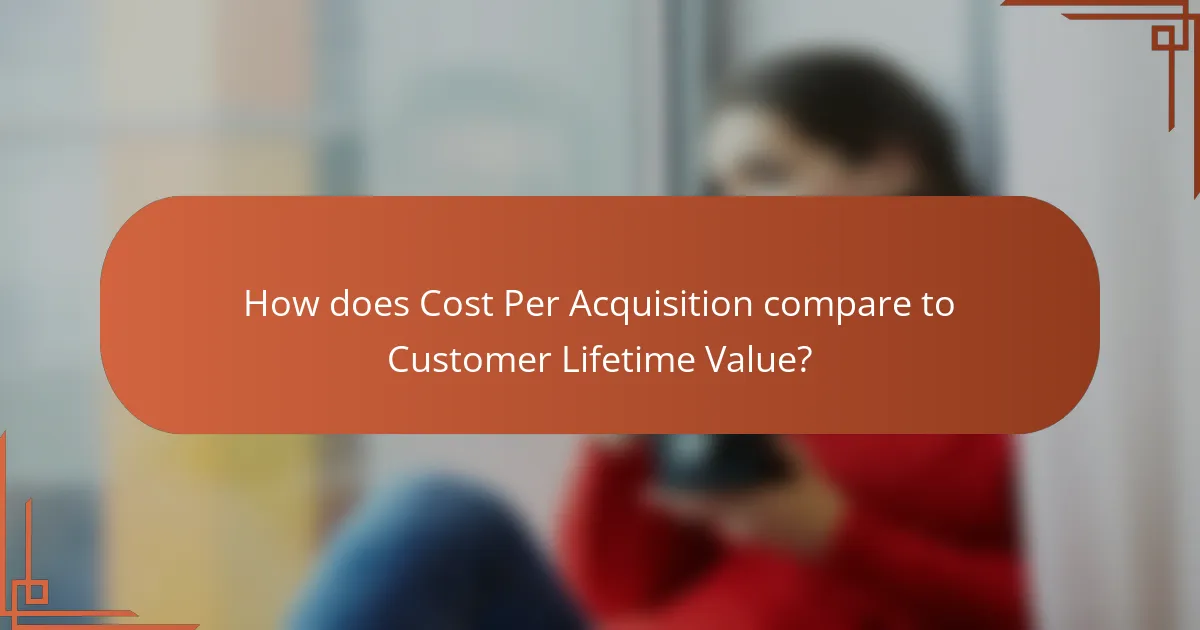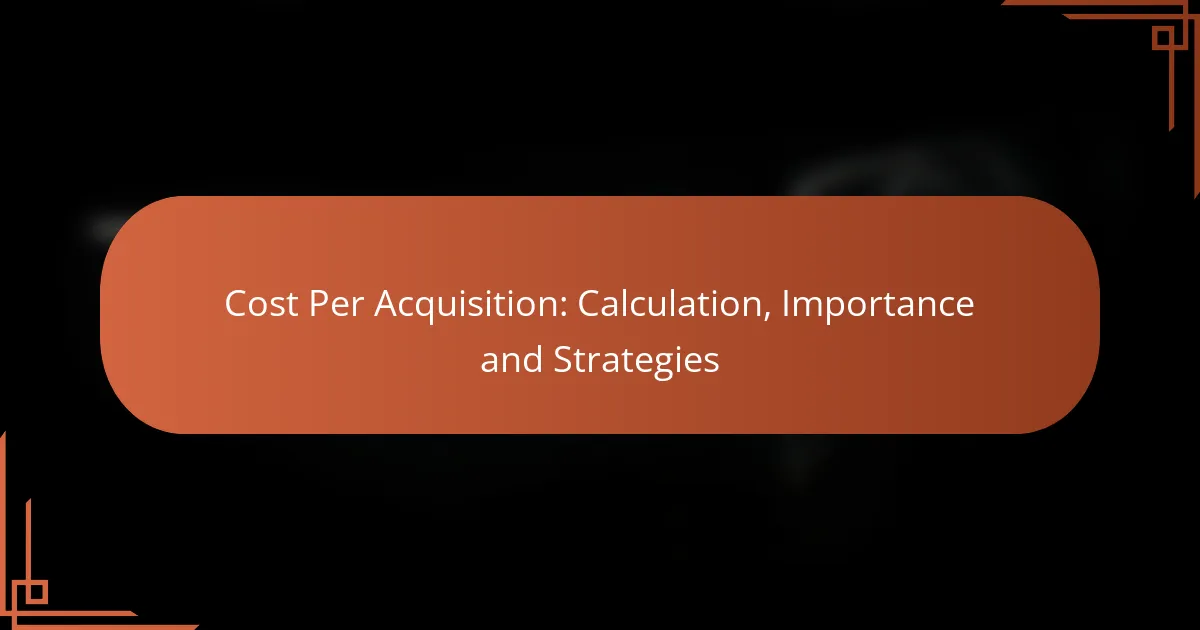Cost Per Acquisition (CPA) is a vital metric in advertising that measures the total cost incurred to acquire a customer. By calculating CPA, businesses can optimize their marketing strategies and budget allocations, ensuring a higher return on investment. Implementing targeted strategies can further reduce CPA, enhancing the overall effectiveness of marketing campaigns.

How to calculate Cost Per Acquisition in display advertising?
Cost Per Acquisition (CPA) in display advertising is calculated by dividing the total cost of advertising by the number of conversions achieved. This metric helps advertisers understand how much they are spending to acquire each customer, allowing for better budget management and campaign optimization.
Formula for Cost Per Acquisition
The formula for calculating Cost Per Acquisition is straightforward: CPA = Total Advertising Cost / Total Conversions. For example, if you spent $1,000 on a display ad campaign and acquired 100 customers, your CPA would be $10. This simple calculation provides insight into the effectiveness of your advertising spend.
It’s important to include all relevant costs in your total advertising cost, such as creative development, media buying, and any associated fees. This ensures a more accurate CPA that reflects the true cost of acquiring customers.
Factors affecting Cost Per Acquisition
Additionally, seasonality and market trends can impact CPA. During peak shopping seasons, competition may drive up advertising costs, resulting in a higher CPA. Regularly analyzing these factors can help you adjust your strategy to maintain a favorable CPA.

Why is Cost Per Acquisition important for advertisers?
Cost Per Acquisition (CPA) is crucial for advertisers as it measures the cost associated with acquiring a customer. Understanding CPA helps businesses optimize their marketing strategies and allocate budgets effectively to maximize return on investment.
Impact on marketing budget
CPA directly influences how much advertisers can spend on acquiring new customers. By calculating CPA, businesses can determine their maximum allowable cost per customer while still achieving profitability. This ensures that marketing budgets are allocated efficiently, preventing overspending on ineffective campaigns.
For example, if a company has a CPA of $50 and a product that generates $200 in profit per sale, it can confidently invest in campaigns that maintain or lower this CPA. Regularly reviewing and adjusting CPA can help keep marketing expenses in line with revenue goals.
Influence on campaign performance
Understanding CPA allows advertisers to assess the effectiveness of their marketing campaigns. A high CPA may indicate that a campaign is not reaching the right audience or that the messaging needs adjustment. Monitoring CPA helps identify which channels and strategies yield the best results.
For instance, if social media ads have a CPA of $30 while email marketing has a CPA of $15, the advertiser may choose to allocate more budget to email campaigns. This data-driven approach enhances overall campaign performance and ensures resources are used where they are most effective.

What strategies can reduce Cost Per Acquisition?
To reduce Cost Per Acquisition (CPA), businesses can implement targeted strategies that enhance efficiency and effectiveness in their marketing efforts. Key approaches include optimizing ad targeting and improving landing page conversion rates.
Optimizing ad targeting
Optimizing ad targeting involves refining your audience selection to ensure that your ads reach the most relevant potential customers. By using demographic, geographic, and behavioral data, you can tailor your campaigns to specific segments, which can significantly lower CPA.
Consider utilizing tools like Google Ads or Facebook Ads Manager to analyze audience insights. For instance, targeting users who have previously engaged with your brand can yield higher conversion rates, often reducing CPA by a notable percentage.
Improving landing page conversion rates
Improving landing page conversion rates is crucial for lowering CPA, as a well-designed landing page can turn visitors into customers. Focus on clear calls to action, concise messaging, and an intuitive layout to enhance user experience.
Testing different elements, such as headlines, images, and button placements, can provide insights into what resonates best with your audience. A/B testing can be particularly effective, allowing you to compare variations and implement the most successful ones, potentially boosting conversion rates by tens of percent.

How does Cost Per Acquisition compare to Customer Lifetime Value?
Cost Per Acquisition (CPA) and Customer Lifetime Value (CLV) are crucial metrics in evaluating the effectiveness of marketing strategies. While CPA measures the cost incurred to acquire a new customer, CLV estimates the total revenue a customer will generate over their lifetime, highlighting the importance of balancing these two figures for sustainable growth.
Definition of Customer Lifetime Value
Customer Lifetime Value (CLV) is the total revenue a business can expect from a single customer account throughout the duration of their relationship. It takes into account factors such as purchase frequency, average order value, and customer retention rates. Understanding CLV helps businesses identify how much they can afford to spend on acquiring new customers.
To calculate CLV, businesses often use the formula: CLV = Average Purchase Value x Purchase Frequency x Customer Lifespan. This calculation provides a clear picture of the potential value each customer brings, guiding marketing and sales strategies.
Importance of the relationship between CPA and CLV
The relationship between CPA and CLV is vital for determining the profitability of customer acquisition efforts. Ideally, CLV should significantly exceed CPA to ensure that the business is generating a profit from its marketing investments. A common benchmark is that CLV should be at least three times higher than CPA.
Monitoring this relationship helps businesses make informed decisions about their marketing budgets and strategies. If CPA approaches or exceeds CLV, it may indicate the need to optimize marketing campaigns or improve customer retention efforts to enhance overall profitability.

What are the common pitfalls in managing Cost Per Acquisition?
Common pitfalls in managing Cost Per Acquisition (CPA) can lead to overspending and ineffective marketing strategies. Recognizing these issues is crucial for optimizing your marketing budget and improving overall performance.
Overlooking data analysis
Failing to analyze data can result in missed opportunities to refine your CPA strategy. Regularly reviewing metrics such as conversion rates, customer behavior, and channel performance helps identify trends and areas for improvement.
Utilize tools like Google Analytics or CRM software to gather insights. For instance, if a particular ad campaign shows a high CPA, you can adjust targeting or creative elements to enhance effectiveness.
Neglecting audience segmentation
Ignoring audience segmentation can lead to a one-size-fits-all approach that increases CPA. By dividing your audience into distinct groups based on demographics, interests, or behaviors, you can tailor your marketing efforts to resonate better with each segment.
For example, targeting younger consumers with social media ads while using email marketing for older demographics can significantly improve engagement and reduce acquisition costs. Always test different strategies for each segment to find the most effective approach.

What tools can help track Cost Per Acquisition?
Several tools can effectively track Cost Per Acquisition (CPA), helping businesses understand their marketing efficiency. These tools provide insights into customer behavior and campaign performance, enabling better decision-making.
Google Analytics for CPA tracking
Google Analytics is a powerful tool for tracking CPA by measuring the effectiveness of your online marketing campaigns. By setting up goals and e-commerce tracking, you can see how much you spend to acquire each customer through various channels.
To use Google Analytics for CPA tracking, ensure that you have defined your goals clearly. This includes tracking conversions, setting up UTM parameters for campaigns, and analyzing traffic sources. Regularly review your CPA metrics to identify trends and optimize your marketing strategies.
Facebook Ads Manager insights
Facebook Ads Manager offers detailed insights into your advertising campaigns, including CPA metrics. It allows you to see how much you are spending to acquire customers through targeted ads on the platform.
To effectively track CPA in Facebook Ads Manager, focus on the breakdown of your ad performance by audience, placement, and campaign type. Utilize A/B testing to refine your ads and lower your CPA. Regularly adjust your targeting and budget based on the performance data to maximize your return on investment.

What emerging trends are influencing Cost Per Acquisition strategies?
Emerging trends are reshaping Cost Per Acquisition (CPA) strategies by leveraging advanced technologies and prioritizing customer-centric approaches. Businesses are increasingly adopting innovative techniques to optimize their CPA while enhancing the overall customer journey.
AI-driven optimization techniques
AI-driven optimization techniques are revolutionizing how companies calculate and manage their CPA. By utilizing machine learning algorithms, businesses can analyze vast amounts of data to identify patterns and predict customer behavior, allowing for more targeted marketing efforts.
For example, AI can help determine the most effective channels for customer acquisition, enabling companies to allocate their budgets more efficiently. This can lead to a reduction in CPA by focusing on high-performing strategies and eliminating underperforming ones.
Increased focus on customer experience
An increased focus on customer experience is becoming essential for lowering CPA. Companies are recognizing that a positive customer journey not only attracts new clients but also encourages repeat business, ultimately reducing acquisition costs.
Strategies such as personalized marketing, responsive customer service, and streamlined purchasing processes can significantly enhance customer satisfaction. Businesses should regularly gather feedback and analyze customer interactions to refine their approaches and ensure they meet evolving expectations.
